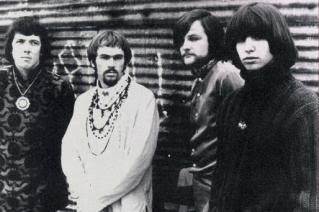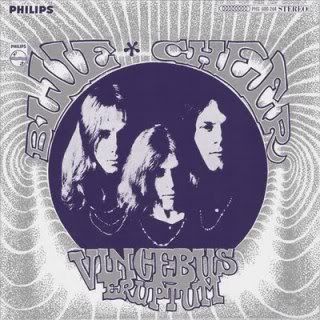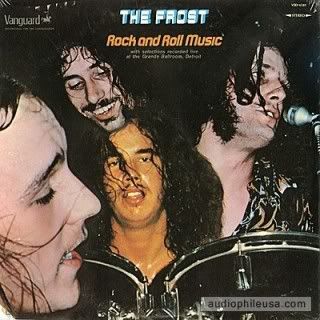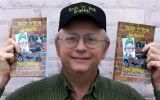
Iron Butterfly's epic "In-A-Gadda-Da-Vida"
was immensely popular all around the country,
including at least one neighborhood in Escanaba,
in the summer of 1968.
By STEVE SEYMOUR
Owning a store which sells used records and compact discs can have advantages.
That's because I get to look at the pre-owned product before it hits the shelves.
Occasionally, interesting things show up.
Recently, for example, one customer traded-in a dozen Iron Butterfly and Blue Cheer CD's, while another sold his old albums, including titles by Savage Grace and the Frost, two vintage Michigan groups.
You might not have heard of those bands, but I have.
They were very cool in the 1968-1971 period.
I lusted after those albums, but as a young student, didn't have the money to buy them.
Based in San Diego, Iron Butterfly first grabbed my attention when I heard "In-A-Gadda-Da-Vida" on the radio in the summer of 1968.
Wisely, Atco Records edited the original 17- minute album opus into a 3-minute single suitable for radio airplay and sale as a 45 rpm record for less than $1.
My brother Mark and I decided that the entire neighborhood would appreciate the song as much as we did.
So, we took the portable stereo I received the previous Christmas, pointed the speakers out our second story bedroom window and played "In-A-Gadda-Da-Vida" to our backyard audience. Then we played it over and over again.
We tired of the experiment after a while but I never stopped liking the song. Neither did the public, with the possible exception of our neighbors.
As a single, "In-A-Gadda-Da-Vida" reached the Top 30 that summer and resurfaced for another chart run a year later.
The song was written by Doug Ingle, Iron Butterfly's frontman, vocalist and keyboard player.
Legend has it that Ingle had a bit too much Red Mountain wine to drink the day he came up with a new song which included the words "in the garden of Eden." Ingle slurred the phrase, drummer Ron Bushy liked it, and a rock classic was born.
Iron Butterfly's baroque sound was wildly popular, and for a time they were the biggest-selling group in the history of Atlantic Records.
In the realm of "heavy" groups, Iron Butterfly was often compared to Blue Cheer, a power trio hailing from San Francisco.
Blue Cheer earned their early reputation with an updated version of "Summertime Blues," which surged onto the airwaves in the spring of 1968.
Originally, early rock 'n' roll guitarist and singer Eddie Cochran, who penned the number, took it into the Top Ten in 1958.
Comprised of Dickie Peterson (vocals, bass), Leigh Stephens (guitar) and Paul Whatley (drums), Blue Cheer revved-up Cochran's song and it became a smash for the second time.
The song was contained on their first album, "Vincebus Eruptum," today considered to be a cult masterpiece.
Like Iron Butterfly, Blue Cheer was a powerful live band.
The group's last U. S. tour came in 2007 in conjunction with the release of their "What Doesn't Kill You..." compact disc.
Another tour was in the works to support a recently released Blue Cheer video when frontman Peterson was diagnosed with cancer.
Sadly, the 63-year-old singer and bass player died on Oct. 12, 2009, putting future activity in the Blue Cheer camp into question.
While Iron Butterfly and Blue Cheer registered a handful of national hits, Savage Grace and the Frost achieved most of their success in Michigan.
Still, both groups were hugely popular in the hard rock scene based in southeastern lower Michigan in the late 1960s and early 70s.
The Frost recorded their "Rock and Roll Music" album live at the Grande Ballroom in Detroit.
Issued by Vanguard Recording Society in 1969, the disc contains some memorable music, including the title track, written by frontman Dick Wagner.
In fact, Wagner composed all the material on the LP except "Donny's Blues," penned by rhythm guitarist Don Hartman.
Vanguard couldn't capture the Frost's exciting live shows on disc, and as a label marketing jazz recordings, didn't have the expertise to promote a hard rock band.
While the Frost had the music chops to make it nationally, they broke up after three LPs.
Savage Grace, meanwhile, only lasted a few years, but issued two long-players, "Savage Grace" and "Savage Grace 2." They even managed a non-LP 45 called "Ivy."
The band was comprised of John Seanor (piano, harpsichord), Larry Zack (drums, percussion), Al Jacquez (lead vocals, bass) and Ron Koss (lead vocals, rhythm and lead guitars).
Issued on Reprise Records in 1970, their debut album included an innovative take on "All Along The Watchtower," the Bob Dylan tune which was also recorded by rock icon Jimi Hendrix.
Moog synthesiser innovator Bernie Krause, who worked with Beatle George Harrison, also lent a hand to the project.
Six other songs on the disc are band originals, with everyone sharing vocal duties, except Zack.
The band found "All Along the Watchtower" to be a concert favorite. They played several dates at Northern Michigan University in Marquette, some on a bill with rock band SRC.
After their second LP failed in 1971, Reprise cut the band from their roster of artists. However, Seaner and Koss stayed with the label for another year, issuing a self-titled album.
Jacquez is now a member of blues band Measured Chaos which has also played shows in the Upper Peninsula in recent years.
Whether you're talking about Savage Grace, the Frost, Blue Cheer or Iron Butterfly, they all have a story to tell.
As for me, I'm listening to a small collection of recordings I'd wished I'd owned since I was a kid.


 I've enjoyed rock music and writing since I was a teenager in the 60s. I feel lucky to have been around when rock's greatest stars created their most enduring hits. At the same time I found I enjoyed writing, as well. I worked on my high school newspaper and magazine, was editor of several college publications and earned a bachelor's degree from Central Michigan University in 1973. I worked for the daily newspaper in my hometown after graduating, becoming managing editor after a few years. By the 1980s, I moved into public relations. In 1985, my wife Sue and I opened a retail music store, The Record Rack, which we still own. Rock 'n' roll has been integral to me and for the last 2O years I've been earning my living from it even though I don't have a musical bone in my body. In recent years, I've also I edited a small local magazine and launched a micro FM radio station. Now, I'm finally combining my love of writing and rock 'n' roll. I can't sing a note, but I know what I like. I'll tell you all about it when you read on. I hope you have as much enjoyment reading these installments as I've had writing them.
I've enjoyed rock music and writing since I was a teenager in the 60s. I feel lucky to have been around when rock's greatest stars created their most enduring hits. At the same time I found I enjoyed writing, as well. I worked on my high school newspaper and magazine, was editor of several college publications and earned a bachelor's degree from Central Michigan University in 1973. I worked for the daily newspaper in my hometown after graduating, becoming managing editor after a few years. By the 1980s, I moved into public relations. In 1985, my wife Sue and I opened a retail music store, The Record Rack, which we still own. Rock 'n' roll has been integral to me and for the last 2O years I've been earning my living from it even though I don't have a musical bone in my body. In recent years, I've also I edited a small local magazine and launched a micro FM radio station. Now, I'm finally combining my love of writing and rock 'n' roll. I can't sing a note, but I know what I like. I'll tell you all about it when you read on. I hope you have as much enjoyment reading these installments as I've had writing them.


No comments:
Post a Comment